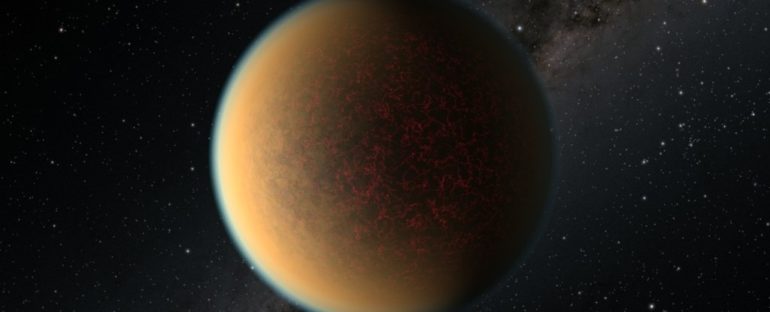Five years after its discovery, one of the Milky Way’s most exciting exoplanets just got even more intriguing. GJ 1132 b, once hailed as one of the most important planets outside the Solar System, appears to have lost its atmosphere – and has since grown a new one.
This could be the first time we’ve identified an exoplanet that has significantly reformed its atmosphere with volcanic activity.
Not only has this allowed scientists to study the magmatic composition of an exoplanet by studying its atmosphere, it raises the possibility that many more exoplanets of this kind could be harboring atmospheres that we might be able to probe. A paper describing the results has been accepted into The Astronomical Journal, with a preprint available on arXiv.
“It’s super exciting because we believe the atmosphere that we see now was regenerated, so it could be a secondary atmosphere,” said astronomer Raissa Estrela of NASA’s Jet Propulsion Laboratory (JPL) in Pasadena, California.
“We first thought that these highly irradiated planets could be pretty boring because we believed that they lost their atmospheres. But we looked at existing observations of this planet with Hubble and said, ‘Oh no, there is an atmosphere there.'”
GJ 1132 b posed a puzzle to scientists. Its discovery was announced in 2015 to much fanfare. It’s a rocky world, 1.66 times the mass and 1.16 times the size of Earth – and it’s just 41 light-years away. Astronomers thought that studying it could help us better understand the rocky planets in our own Solar System (like Earth, Venus, and Mars).
There are some important differences, though. GJ 1132 b is on a 1.6-day orbit around its host star, GJ 1132. Although GJ 1132, a small red dwarf, is a lot cooler and dimmer than the Sun, its temperature would still be scorchingly hot – around 530 Kelvin (257 °C, 494 °F). It would also lash GJ 1132 b with 19 times the incident stellar radiation Earth receives from the Sun.
In addition, GJ 1132 b is thought to have started out as a very different kind of exoplanet from Earth, Mars, and Venus. Astronomers believe the exoplanet started out as a mini-Neptune – smaller than Neptune but bigger than Earth – and what remains is the rocky core after its original hydrogen atmosphere was evaporated away by stellar radiation during the exoplanet’s 5 billion-year lifespan, leaking away in just a few hundreds of millions of years.
Astronomers then used the MPG/ESO telescope in Chile to observe the exoplanet as it passed between us and its star. These transits cause faint dips in the starlight – but, if an exoplanet has an atmosphere, some wavelengths of light can be absorbed or emitted by the atoms in the atmosphere, revealing the presence of various elements.
According to the MPG/ESO data, GJ 1132 b did indeed have an atmosphere – and it seemed hydrogen-rich, which was consistent with the mini-Neptune scenario.
Now, a closer look at the exoplanet with the Hubble Space Telescope has turned that notion upside down.
It’s not a simple hydrogen atmosphere that GJ 1132 b harbors, the Hubble data revealed. Instead, it’s a complex mix of hydrogen, hydrogen cyanide, methane, and ammonia, with a thick hydrocarbon haze similar to Earth’s smog.
According to the team’s data, the atmospheric pressure at the surface is similar to Earth’s atmospheric pressure. Since this atmosphere is still leaking into space, that seems quite astonishing.
To figure out what’s going on, the team turned to computer modeling. It seems that the most likely explanation is that GJ 1132 b’s original hydrogen atmosphere was absorbed into the ocean of molten magma that covered the exoplanet when it was still very young.
Although the exoplanet’s surface has cooled by now, the interior is still warm and active as gravitational interactions with the star keep it hot and mushy. Volcanic activity is releasing that hydrogen, among other elements, to form a new atmosphere. As the atmosphere leaks away, it’s replenished by hydrogen still stored in GJ 1132 b’s mantle.
This finding could explain why there are so many mini-Neptunes out there. It could also mean that starting life as a mini Neptune is one pathway to creating worlds like Earth, Venus, and Mars – rocky, volcanically active (at least at one time), and harboring an atmosphere.
“How many terrestrial planets don’t begin as terrestrials? Some may start as sub-Neptunes, and they become terrestrials through a mechanism that photo-evaporates the primordial atmosphere. This process works early in a planet’s life, when the star is hotter,” said astronomer Mark Swain of JPL, the lead author on the research.
“Then the star cools down and the planet’s just sitting there. So you’ve got this mechanism where you can cook off the atmosphere in the first 100 million years, and then things settle down. And if you can regenerate the atmosphere, maybe you can keep it.”
It’s also extremely interesting in its own right. The atmospheric composition of GJ 1132 b, even with the limited observations we have been able to obtain, reveals the geological processes in the interior of an exoplanet 41 light-years away. That’s wild – but also suggests that we might be able to learn even more when next-gen instruments like the James Webb Space Telescope get going.
“This second atmosphere comes from the surface and interior of the planet, and so it is a window onto the geology of another world,” said astronomer Paul Rimmer of the University of Cambridge in the UK.
“A lot more work needs to be done to properly look through it, but the discovery of this window is of great importance.”
The research will be published in The Astronomical Journal, and is available on arXiv.
